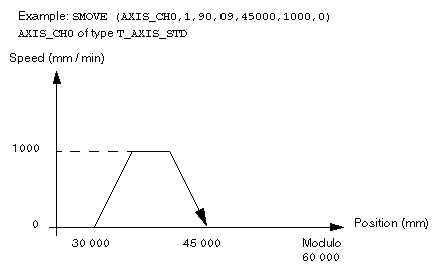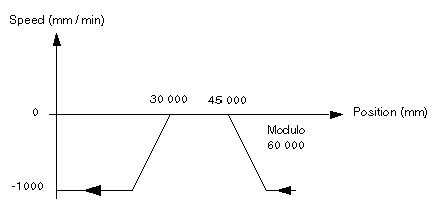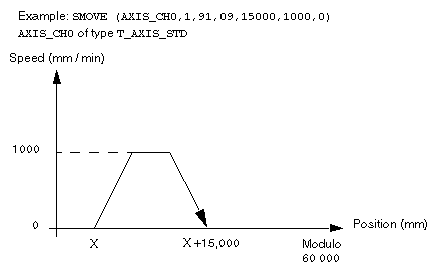3 types of movement categories can be programmed:
-
movements on a position (instruction codes 01 and 09),
-
movements until event detection (instruction codes 10 and 11),
-
reference points (instruction code 14).
The reach position and speed must be set while programming. Acceleration parameters (e.g. rectangular, trapezoidal or triangular) are set in the configuration.
Whatever the current position and target may be, it is always possible to reach the objective position in + direction as well as – direction. There are 3 possible ways to go from point A to point B:
-
ascending position movement (movement 1),
-
descending position movement (movement 2),
-
for the shortest movement: the module decides on the direction (movement 3)
The required direction of movement is specified by the speed sign.
With an infinite machine, movements can be of the following type:
-
Shortest movement in relation to the machine homing point (code 90). In this case, the shortest path determines the direction of movement.
-
Set direction movement in relation to the machine homing point (code 60). In this case, the speed sign determines the direction of movement.
-
Shortest movement in relation to stored PREF1 position (code 98).
For example, SMOVE (AXIS_CH0,1,98,09,45000,1000,0) targets (45000 + PREF1).
-
In opposite direction in relation to stored PREF1 position (code 68).
For example, SMOVE (AXIS_CH0,1,68,09,45000,-1000,0) targets (45000 + PREF1) value while moving in – direction.
For example, SMOVE (AXIS_CH0,1,68,09,45000,1000,0) targets (45000 + PREF1) value while moving in + direction.
-
Relative in relation to current position (code 91). In this case, direction of movement is determined by the X parameter sign (position increment).
NOTE: The value targeted by G68 or G91 is calculated in relation to the modulo. (1000 + PREF1) Mod ModuloValue and (X + 15000) Mod ModuloValue are targeted in the examples. Mod is the Modulo mathematical operator.
For example, if PREF1 = 40000 and modulo = 60000: 45000 + PREF1 corresponds to 25000.



